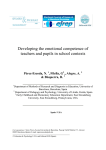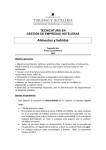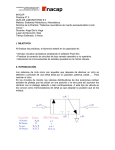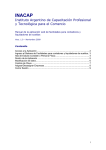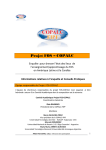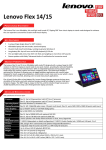Download proposed method for making the impact assessment proyecto 50
Transcript
PROPOSED METHOD FOR MAKING THE IMPACT ASSESSMENT PROYECTO 50 AREA AT EAFIT UNIVERSITY April 8th 2015 Johan Steward Rios-Naranjo Tutor: Claudia Maria Zea-Restrepo Description of the areas of Proyecto 50 • The content area is comprised of an interdisciplinary team accompanying teachers Eafit in searching, updating and creating new digital educational resources • The project technology area is responsible for providing the necessary technological tools for digital educational content deployment, also generates technological innovation initiatives that may be applicable in innovation projects • The accompanying learning area teachers in the consolidation and development of skills for educational innovation, from training scenario development, experimentation, socialization and educational research in teaching and learning environments, setting educational research projects that impact directly teachers, groups and students. Meeting Summaries • As part of the Proyecto 50 projects have considered some variables that affect these projects and can be analyzed with existing data and both quantitative and qualitative methodologies. • • • • • The use of ICT in the teaching population Academic performance Cognitive skills motivation The perception of the course the students • In (UNESCO Institute for Statistics, 2009) a number of existing indicators which can be measured using ICT are mentioned. • In (ECLAC, 2010) are considered targets for compiling statistics on the use of ICT. PRODUCTS OF EDUCATION Name Population Impacted Target Nivelatorio Becas Aportes de Empleados New Students Academic Performance Itinerario de monitores Students and P50´s monitors Academic Performance, Use of ICT Teachers and students Motivation, qualification from students to teachers Tutors in Universidad de los niños, (Future students) Academic performance Jose fernando sistemas Itinerario de mapas conceptuales Methodological Measurement Strategy Initial considerations • PROYECTO 50 carries and creating content and training teachers over four years, despite this, in all this time there have been no studies to determine whether the measure EAFIT to create this center for technological and educational innovation to transform teaching in the classroom was positive or if instead only represents more expense to the University. • From this it is necessary to have knowledge about the processes taking place in PROYECTO 50 and how they have contributed, through innovation, to a change in the teaching in the classroom. Initial considerations • It may take considerable time before the effects of a project are evident (Georghiou, 1998), as an innovation process usually requires first a process of acceptance and adaptation another to be able to fully implement. • Evaluative approaches for objective or based on performance indicators can be useful for tracking the status of a project, to ensure that innovative activities remain active and are going more or less on track. • A small number of key impacts caused by a minority of projects or participants can be much more significant than changes (or average) mean scores. Yet, the most common measure of the impact of a program is usually the mean (Perrin, 2001). Academic performance • The academic performance has been studied repeatedly in educational research and ratings represent the most widely used indicator "(Rodriguez Ayán & Ruíz Díaz, 2011). However the ratings as a measure of performance have been mixed reviews. First, do not necessarily imply quality or depth of knowledge acquired, as the results come in ratings associated with factors and different skills. • This gives rise to an analysis of academic achievement in view of the student and all environments in which plays in their daily lives and skills that they have provided to demist certain tasks that may affect their grades. • Academic performance indicators considered are taken from (Garbanzo Vargas, 2007), and most have been used in different studies in higher education. Determinants in academic performance Images taken (Garbanzo Vargas, 2007) Determinants in academic performance Images taken (Garbanzo Vargas, 2007) Determinants in academic performance Images taken (Garbanzo Vargas, 2007) Cognitive skills • To solve these technical factors both quantitative and qualitative analysis are discussed as it relates to qualitative variables. • For analysis skills (E. Ruiz, 2007) recommends designing skills assessment instruments in order to obtain evidence to identify and recognize a range of skills acquired through experience in the environment in which the student plays . • Cognitive skills are described as methodologies employed in the management of knowledge and its association with educational content and refer them directly to the different intellectual capacities resulting from the willingness or ability shown by individuals to do something. Cognitive skills • To (Clavero, Undated) "Currently we are immersed in the era of technological revolution and, therefore, the number of cultural and technical knowledge, theories and skills, models and strategies, etc., increase exponentially; being so that education faces the great challenge of transmitting simultaneously linking the theoretical with real life increasingly difficult to solve problem. Also, curious and paradoxically full patient being in the age of social media, we find the highest levels, historically speaking, personal isolation; which greatly exacerbates this problem. " • Therefore today cognitive ability par excellence, if not the only, is memorizing class notes or exposure teacher, so the method of study of many students is to memorize what they learned in class, doing basically they learn only to the time of evaluation. Motivation • This is when comes to play an important role motivation. The motivation of students in class can generate other cognitive skills are developed and are interested vary their methods of study. For this it is necessary to measure motivation to determine whether it should not intervene to improve motivation. • The experimental works have identified patterns of teaching performance that generally have a positive effect on student motivation. However, this effect does not always occur does not in the same degree. This fact suggests that perhaps does not influence the environment itself, but its effect depends on the goals that students pursue (Alvarez & Bisquerra, 2007). • This is determined that motivation is also associated with several factors that influence it, so the existence of correlation between the chosen variables becomes evident. • In (National University of Distance Education, undated) the types of analysis that can be grouped into 4 categories and measurement techniques for such analyzes are mentioned. Use of ICT and perception • The use of ICT as a tool for improvement exposed other variables, means that a change in teaching methodologies in the classroom and is considered to have an impact on the perception of the students regarding the course and for the teacher. • In a report from the Universidad del Valle in Cali, (Universidad del Valle, 2012), reveals that higher education institutions require information on the quality of academic and administrative services provided, in order to establish priorities to guide internal process improvement. Because the student is the sector that benefits directly from the fulfillment of the academic purpose of the university, it is legitimate to ask systematic and rigorous way, how satisfied are you with the academic and non-academic services offered. • The organization benefits while at detecting flaws that owns and fed back from the information provided by students, alumni and teachers achieve the satisfaction of those who are its reason for being, thus increasing their quality (Universidad del Valle, 2012 ). References • • • • • • CEPAL. (2010). Indicadores sobre acceso a y uso de TIC en Censos. Santiago de Chile: CEPAL-División de Desarrollo Productivo y Empresarial. Garbanzo Vargas, G. M. (2007). FACTORES ASOCIADOS AL RENDIMIENTO ACADÉMICO EN ESTUDIANTES UNIVERSITARIOS, UNA REFLEXIÓN DESDE LA CALIDAD DE LA EDUCACIÓN SUPERIOR PÚBLICA. San José: Universidad de Costa Rica. Georghiou, L. (1998). Issues in the evaluation of Innovation and Technology Policy. Mendoza Mendoza, A. (2011). PROPUESTA PARA LA MEDICIÓN DEL RENDIMIENTO ACADÉMICO DE LOS ESTUDIANTES DE LA UNIVERSIDAD LIBRE UTILIZANDO ANÁLISIS ENVOLVENTE DE DATOS (DEA). ACADEMIA LIBRE, Barranquilla. Perrin, B. (2001). How to — and How Not- Evaluate Innovation. Rodriguez Ayán, M. N., & Ruíz Díaz, M. Á. (2011). Indicadores de rendimiento de estudiantes universitarios: calificaciones versus créditos acumulados. Montevideo. References • • • • • • • UNESCO Institute for statistics. (2009). LAS TECNOLOGÍAS DE LA INFORMACIÓN MEDICIÓN DE LAS TECNOLOGÍAS DE LA INFORMACIÓN Y LA COMUNICACIÓN (TIC) EN EDUCACIÓN - MANUAL DEL USUARIO. Montreal. Álvarez, M., & Bisquerra, R. (2007). EVALUACIÓN DE LA MOTIVACIÓN EN LOS ENTORNOS EDUCATIVOS. UNIVERSIDAD AUTÓNOMA DE MADRID. Education National University of Distance. (Sin fecha). TÉCNICAS DE MEDIDA Y ÁMBITOS DE APLICACIÓN. Psicología de la Motivación. Clavero, F. H. (Sin fecha). HABILIDADES COGNITIVAS. Departamento de Psicología Evolutiva y de la Educación. Ruiz E., M. (2007). INSTRUMENTOS DE EVALUACIÓN DE COMPETENCIAS. Santiago de Chile: INACAP. Gobierno de Navarra. (2009). Guía PARA MEDIR LA SATISFACCIÓN RESPECTO A LOS SERVICIOS PRESTADOS. Navarra: Gobierno de Navarra. Universidad del Valle. (2012). MEDICIÓN DE LA SATISFACCIÓN DE USUARIOS DEL VALLE. Cali.
















